Can You Freeze Banana Leaves
You can freeze banana leaves, extending their shelf life up to six months while preserving their natural flavor and aroma. To freeze, simply place them in an airtight container or plastic bag, removing as much air as possible before sealing. Frozen banana leaves can be used in cooking without thawing, and they'll retain their natural flavor and aroma. Store them away from strong-smelling foods, as they can absorb odors easily. When you're ready to use them, simply thaw and wash before incorporating into your recipes. Now that you know the basics, explore the many creative ways you can use frozen banana leaves in your cooking.
This post may contain affiliate links. If you make a purchase through these links, I may earn a commission at no additional cost to you. Additionally, portions of this post may be generated using artificial intelligence (AI) technology. While we strive for accuracy, please be aware that AI-generated content may not always be perfect and should be fact-checked when necessary.
The Spatula Scoops
- Yes, banana leaves can be frozen to extend their shelf life and remain usable for up to six months.
- Frozen banana leaves can be used in cooking without thawing, retaining their natural flavor and aroma.
- To freeze, place banana leaves in an airtight container or plastic bag, removing as much air as possible before sealing.
- Store frozen banana leaves in airtight containers or freezer bags to prevent moisture and other odors from affecting the leaves.
- Frozen banana leaves can be thawed slowly at room temperature or in the refrigerator overnight, and then washed and used in recipes.
Uses and Benefits of Banana Leaves
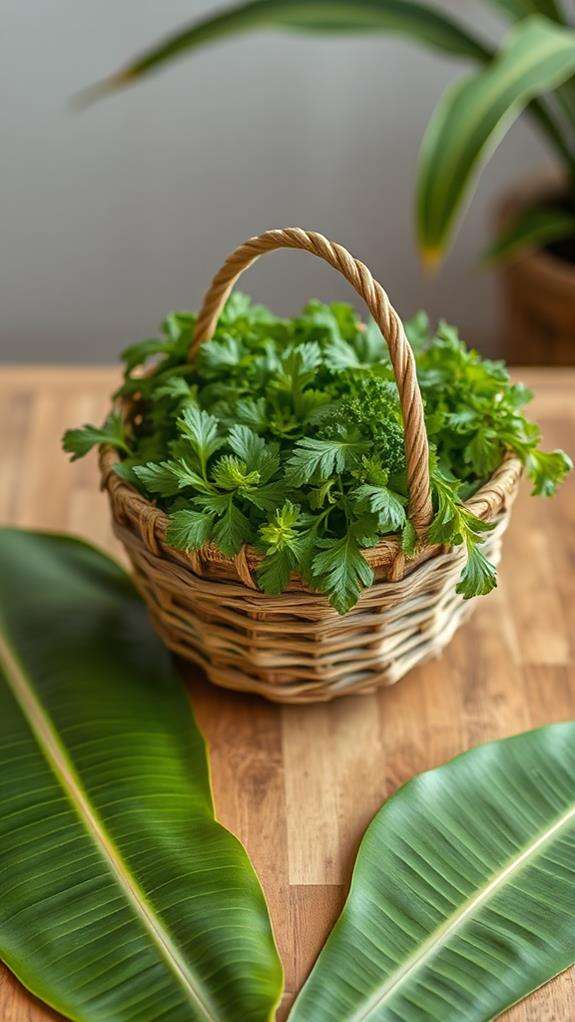
Using banana leaves in your cooking can elevate the flavors and presentation of your dishes while providing a natural, eco-friendly, and inexpensive wrapping material. You can use them to cook a variety of dishes, including fish, sticky rice, and vegetables, and they'll keep the juices inside the leaf packet, preventing food from drying out or burning. Banana leaves are also a great liner for plates or trays, adding color to your table arrangements, and can even be used as plates in some regions, imparting a unique, earthy flavor to cooked food. When meal prepping, consider using silicone freezer molds with convenient fill lines to portion and store your dishes, making cooking and freezing a breeze. They're durable, oven-safe, and dishwasher safe, making them a great addition to your kitchen. You can grill, steam, boil, or deep-fry food with banana leaves, and they contain polyphenols, antioxidants that keep cells healthy. They're also used to make teas and tinctures as home remedies, with potential health benefits due to their nutrient content. If you can't find fresh banana leaves, don't worry – frozen banana leaves can be stored for up to six months, making them a convenient and accessible cooking material. By incorporating banana leaves into your cooking, you'll not only reduce waste but also add a touch of nature to your culinary creations.
Freezing and Storing Banana Leaves
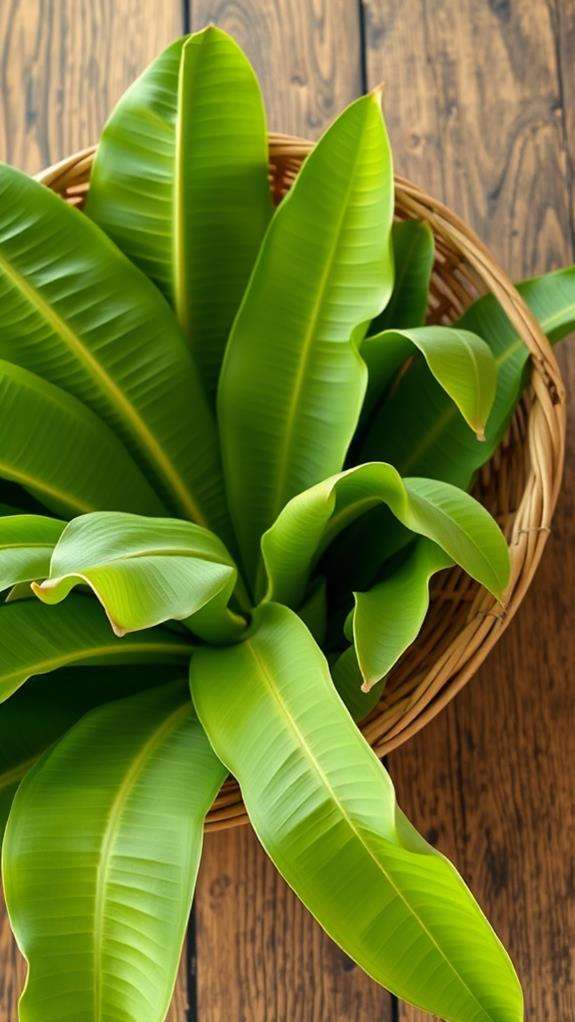
You can extend the shelf life of banana leaves by freezing them, and they'll remain usable for up to six months. To do this, simply place them in an airtight container or plastic bag, making sure to remove as much air as possible before sealing, similar to proper vacuum sealing techniques used for dehydrated foods. When storing dehydrated foods, a crucial step is to maintain a moisture content below 20% to prevent spoilage. Frozen banana leaves can be used in cooking without thawing, and they will retain their natural flavor and aroma. When storing frozen banana leaves, a vital consideration is to keep them away from strong-smelling foods, as they can absorb odors easily. Before using frozen banana leaves, rinse them with cold water to remove any impurities that may have developed during storage. By following these steps, you can enjoy the benefits of banana leaves throughout the year. Frozen banana leaves are perfect for cooking, and their extended shelf life makes them a convenient addition to your pantry.
Choosing and Preparing Banana Leaves
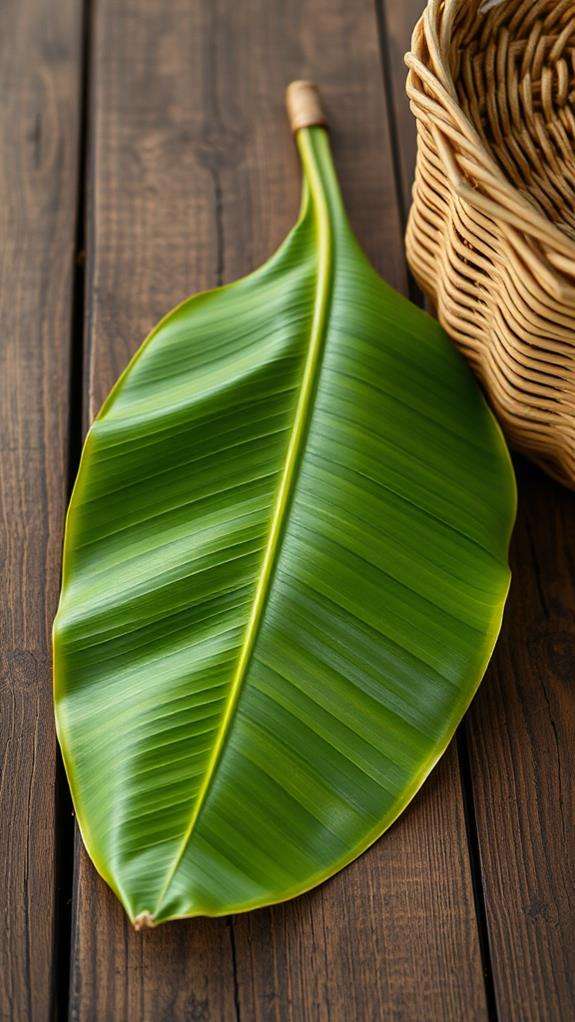
Pick out fresh banana leaves with vibrant green color and no signs of wilting or blemishes, as they'll yield the best flavor and aroma for your dishes. You want to choose leaves that are firm and slightly flexible, with no tears or holes. Avoid leaves with yellow or brown spots, as they may be past their prime or contaminated. When preparing your banana leaves, consider using eco-friendly kitchen utensils like wooden soup spoons made from natural materials to enhance your culinary experience. Once you've selected your fresh banana leaves, give them a quick rinse with cold water to remove any dirt or debris. Gently pat them dry with a paper towel or clean cloth to remove excess moisture. Remove the thick stem from the center of each leaf, and trim any torn or damaged edges. You can also trim the leaves to the desired size for your recipe.
Remember to handle the leaves gently, as they can tear easily. Fresh banana leaves are delicate, so be sure to store them in an airtight container or plastic bag in the refrigerator until you're ready to use them. This will help keep them fresh for up to a week. By choosing and preparing your banana leaves carefully, you'll be able to enjoy their unique flavor and aroma in your favorite dishes.
Cooking With Frozen Banana Leaves
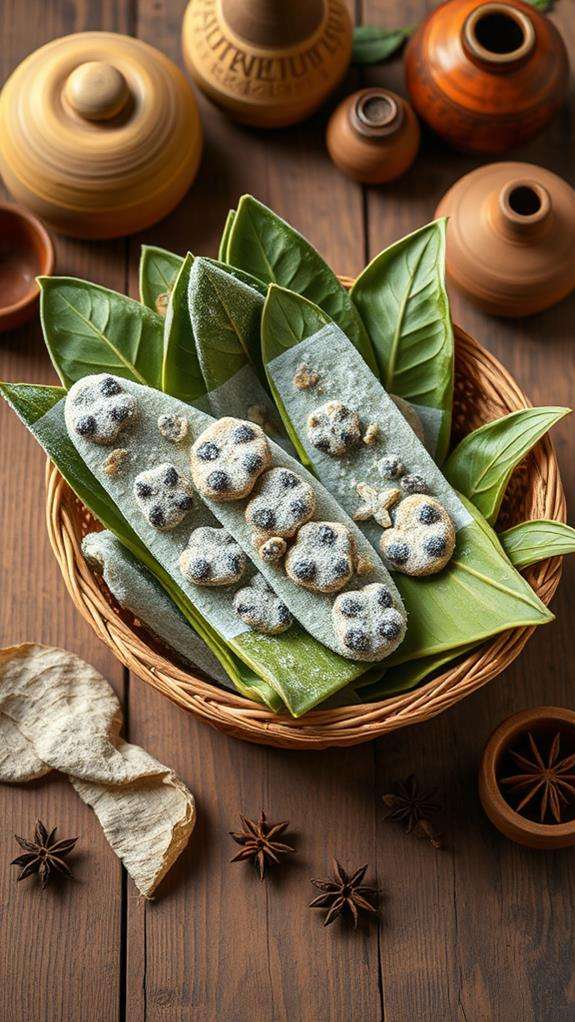
Flexibility is the key to tapping the full potential of banana leaves in your cooking, and frozen banana leaves offer just that. With their year-round availability, you can experiment with new recipes and flavors without worrying about the freshness of the leaves. When using frozen banana leaves, simply thaw them overnight in the refrigerator or soak them in warm water for a few minutes to make them pliable and ready for use. Additionally, using flexible silicone freezer trays like the Souper Cubes Gift Set food-safe silicone can make meal prep and storage a breeze, allowing you to portion out ingredients and freeze them for later use. They're more readily available than fresh ones and add excellent flavor to dishes, making them a convenient alternative for cooking. They can be used multiple times before discarding, making them a sustainable and cost-effective cooking option. They're easy to store and can be kept for up to six months, allowing you to plan your meals ahead. They're just as flavorful as fresh banana leaves, and their frozen state helps retain their natural oils and flavor compounds. They're a great way to add a touch of tropical flavor to your dishes, from soups to steamed vegetables.
Preserving Fresh Banana Leaves Long-Term
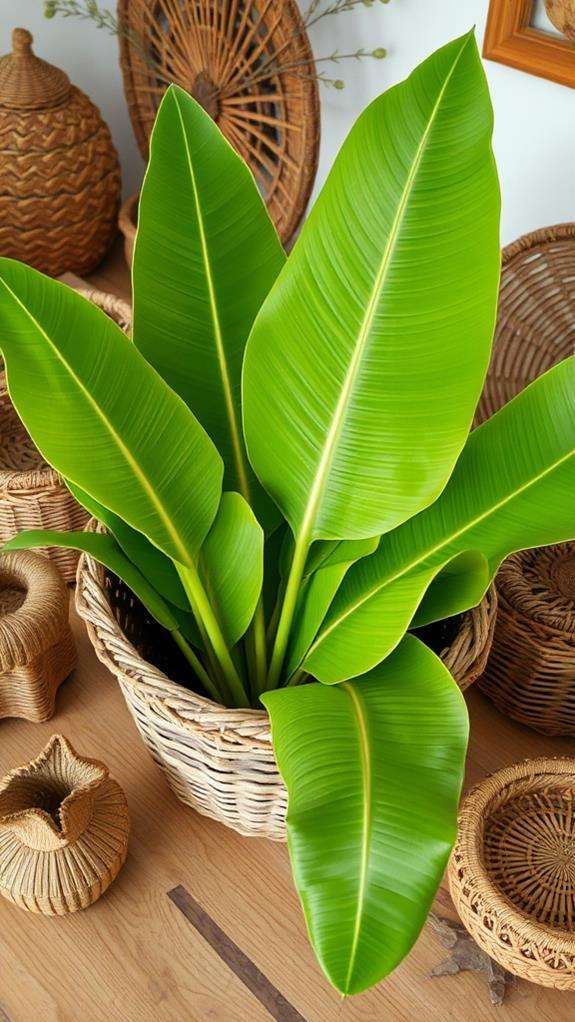
Several bunches of fresh banana leaves can be preserved for an extended period with the right storage techniques, ensuring you have a steady supply for your culinary experiments. To keep them fresh for a longer period, you can store them in the refrigerator for up to 7-10 days. Proper storage helps maintain the natural green color of banana leaves, and they can be used for cooking after freezing and thawing.
| Storage Method | Duration | Benefits |
|---|---|---|
| Refrigeration | 7-10 days | Maintains natural green color, limits exposure to cold air |
| Soaking and Blanching | N/A | Kills microorganisms, retains toughness |
| Freezing | Extended period | Helps retain original state for a longer time |
Handling and Storing Frozen Leaves

Now that you've successfully frozen your banana leaves, crucial to handle and store them properly to maintain their quality and freshness. You'll want to store them in their original packaging or airtight containers to prevent freezer burn and moisture absorption, and keep them at a consistent freezer temperature of 0°F (-18°C) or below. By following these steps, you'll be able to enjoy your frozen banana leaves for up to six months and have them ready to use whenever you need them.
Freezing Procedures
You've carefully frozen your banana leaves, and now it's vital to store them properly to maintain their quality and shelf life. Proper freezing procedures will guarantee your frozen ones remain fresh and usable for a longer period.
When freezing banana leaves, follow these steps:
- Freeze in airtight containers or freezer bags: This prevents freezer burn and other flavors from transferring to your leaves.
- Label and date the containers or bags: Keep track of how long they've been frozen and easily identify them in your freezer.
- Store in the coldest part of the freezer: Typically, this is the bottom shelf, where the temperature remains consistent.
- Use the frozen leaves within 6-8 months: For peak flavor and texture, use them within this timeframe.
- When using, simply thaw and rinse: Frozen banana leaves can be used in a variety of dishes, from soups to stews, and can be easily thawed and rinsed before use.
Proper Storage Methods
After freezing your banana leaves, it's time to focus on handling and storing them properly to maintain their quality and prevent damage. You've worked hard to preserve the leaves, so make sure you store them in a way that keeps them fresh or frozen for as long as possible.
| Storage Method | Description |
|---|---|
| Airtight Containers | Store frozen banana leaves in airtight containers or freezer bags to prevent moisture and other odors from affecting the leaves. |
| Labeling | Label the containers or bags with the date and contents, so you can easily keep track of how long they've been stored. |
| Freezer Organization | Organize your freezer to guarantee the containers or bags are not crushed or damaged. |
| Temperature Control | Keep your freezer at a consistent temperature of 0°F (-18°C) or below to maintain the quality of the frozen leaves.
Thawing Frozen Leaves
Frozen banana leaves are ready to use when you need them, but first, they require proper thawing to maintain their texture and flavor. When you're ready to use your frozen banana leaves, follow these simple steps to thaw them:
- Remove the desired number of frozen leaves from the airtight container or freezer bag.
- Place the frozen leaves in a sealed plastic bag or airtight container to prevent moisture from entering.
- Leave the bag or container at room temperature for a few hours or overnight in the refrigerator to thaw slowly.
- You can also thaw frozen banana leaves by submerging them in cold water, changing the water every 30 minutes until thawed.
- Once thawed, wash the leaves with cold water to remove any impurities, and they're ready to use in your recipe.
Remember to always handle frozen banana leaves gently to prevent tearing or bruising. Proper thawing and handling will guarantee your frozen banana leaves retain their flavor and texture, making them perfect for your next cooking or wrapping project.
Frequently Asked Questions
Do Banana Leaves Freeze Well?
You might wonder if banana leaves can handle the freezing process. The good news is that they do freeze well, and it's a great way to preserve them. By freezing, you'll retain their natural green color and prevent them from becoming brittle. Plus, they'll still be flavorful and usable in cooking after thawing. Just remember to blanch them in boiling water before freezing to kill off microorganisms and keep them tough.
How Do You Preserve Banana Leaves?
As you set out on preserving banana leaves, imagine wrapping your dishes in a vibrant green blanket, infusing your meals with a hint of tropical charm. To make this possible, start by soaking the leaves in water to reduce temperature and clean the surface. Next, blanch them in boiling water for 2-3 minutes to kill microorganisms and retain their tender texture.
What Can I Do With Leftover Banana Leaves?
You're left with extra banana leaves and wondering what to do with them. You can reuse them for cooking or wrap food for steaming. Try making banana leaf wraps for tamales or steamed dumplings. You can also use them as a natural food wrap for snacks or meals. Simply clean and dry the leaves, then store them in an airtight container for future use. Get creative and experiment with different recipes and cuisines that utilize banana leaves!
What Is the Shelf Life of Banana Leaves?
You're wondering about the shelf life of banana leaves. Well, when refrigerated, they can last up to 7-10 days in a plastic bag. However, if you freeze them, they can be stored for an impressive 3-6 months in their original packaging. Proper storage is key to maintaining their natural green color and freshness. By freezing or refrigerating banana leaves, you can extend their shelf life and enjoy them for a longer period.
Conclusion
As you wrap up your banana leaf journey, remember that freezing these versatile wonders is just the beginning. With a stash of frozen leaves, you'll be ready to unfurl a world of flavors and aromas in your kitchen. Think of them as a flavorful safety net, waiting to be thawed and transformed into a culinary masterpiece. So go ahead, get creative, and let the sweet, subtle essence of banana leaves elevate your cooking to new heights.





